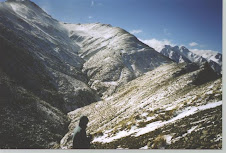The Ruahine Tramping Club was established in the year 2000, by Nigel Robson and myself, as a way to mark participation in, and accomplishment of, a crossing of the Ruahine ranges. The idea originally came to Nigel as he tramped over the Mokai Patea to meet Gustav Risberg and Robb Kloss who were completing the first multiple day crossing amongst the future club members. Meeting high on the Mokai and relishing a few still cold Mac's lagers carried up by Robson, the idea was put forth as a way for like minded people to enjoy the ranges and each others company, and heartily agreed upon as a fine concept. The badge pictured, kindly provided by Nigel, is an actual World War One regimental badge of the now defunct Ruahine Regiment, which we managed to procure a number of from an Auckland trader. Somehow I think the spirits of those now gone men would not disapprove of our use of them.
The original members, in addition to the above mentioned, were John Nash, Gustav Risberg, and Taylor Kloss, whom at age 7 had ramped up a large number of tough trips so as to be included in our ranks as a mark of respect.
Members Kloss and Robson had initially crossed the ranges in the south at Maharahara, a tough one day affair of around 8 hours through the Leatherwood belt. We did this twice in the early days, whetting our appetites for further exploration. The first overnight crossing involved Robson and Kloss climbing over the eastern Rauhines to Leon Kingvig hut, then out via the Ngamoko's and Knight's track, a real learning curve, but a great experience in 1998. The first multiday crossing was done in 2000 by Kloss and Risberg, going up Sunrise track, across Armstrong Saddle to Top Maropea, downriver to Maropea Forks, then over Puketaramea to Otukota hut, and out the other side via the Mokai Patea. The sight of Nigel emerging out of the Mokai mist to meet Gustav and I is something we will not forget. Soon after Kloss, Robson, and Nash went the same way to Maropea Forks, then veered off another ridge to Unknown Campsite and Lake Colenso, then out via Iron Bark hut and the Mokai. The year 2001 saw the addition of two members to our ranks in Rick Parduhn and Steve Davidson, visitors from America. On a wet and wild crossing they joined Kloss on the now familar route to Maropea Forks, then veered off over another ridge to Wakelings hut, then climbing high again to Rongotea and dropping down to Crow hut, before climbing out on the Hikurangi range and Kawhatau base. Their badges were well earned. A few years later Nigel returned from South Korea with his new bride, Young Hae, and along with John Nash, repeated the Lake Colenso crossing, making Young Hae the first female member of the RTC tribe. So the number of members currently stands at 8, and includes Americans, New Zealanders, and Koreans, true international flavour. And while we have no annual dues, no agenda, no meetings, and no rules, we do encourage members to stay in touch and renew their connection to this wild and wonderful place.
The original members, in addition to the above mentioned, were John Nash, Gustav Risberg, and Taylor Kloss, whom at age 7 had ramped up a large number of tough trips so as to be included in our ranks as a mark of respect.
Members Kloss and Robson had initially crossed the ranges in the south at Maharahara, a tough one day affair of around 8 hours through the Leatherwood belt. We did this twice in the early days, whetting our appetites for further exploration. The first overnight crossing involved Robson and Kloss climbing over the eastern Rauhines to Leon Kingvig hut, then out via the Ngamoko's and Knight's track, a real learning curve, but a great experience in 1998. The first multiday crossing was done in 2000 by Kloss and Risberg, going up Sunrise track, across Armstrong Saddle to Top Maropea, downriver to Maropea Forks, then over Puketaramea to Otukota hut, and out the other side via the Mokai Patea. The sight of Nigel emerging out of the Mokai mist to meet Gustav and I is something we will not forget. Soon after Kloss, Robson, and Nash went the same way to Maropea Forks, then veered off another ridge to Unknown Campsite and Lake Colenso, then out via Iron Bark hut and the Mokai. The year 2001 saw the addition of two members to our ranks in Rick Parduhn and Steve Davidson, visitors from America. On a wet and wild crossing they joined Kloss on the now familar route to Maropea Forks, then veered off over another ridge to Wakelings hut, then climbing high again to Rongotea and dropping down to Crow hut, before climbing out on the Hikurangi range and Kawhatau base. Their badges were well earned. A few years later Nigel returned from South Korea with his new bride, Young Hae, and along with John Nash, repeated the Lake Colenso crossing, making Young Hae the first female member of the RTC tribe. So the number of members currently stands at 8, and includes Americans, New Zealanders, and Koreans, true international flavour. And while we have no annual dues, no agenda, no meetings, and no rules, we do encourage members to stay in touch and renew their connection to this wild and wonderful place.
















